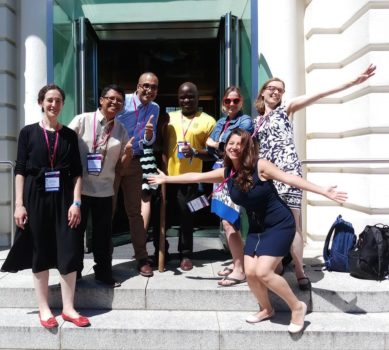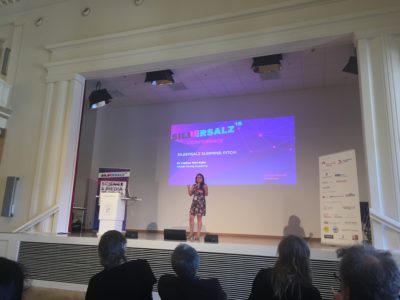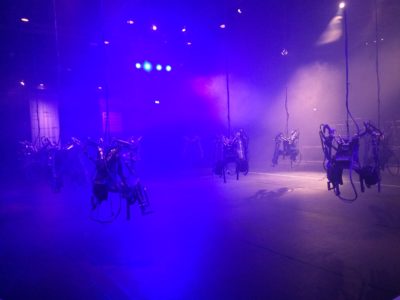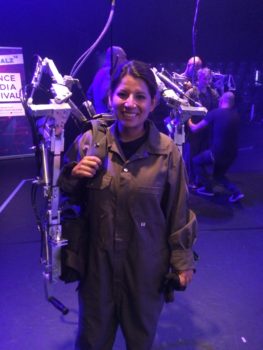From 28 June to 1 July, the first science media film festival – ‘SILBERSALZ’ – took place in Halle (Saale), coordinated by Documentary Campus and supported by the Robert Bosch Foundation. In the context of this city-wide festival, a two-day conference, bringing together scientists and scholars and media professionals, was hosted at the German National Academy of Sciences Leopoldina. Supported by the Robert Bosch Foundation and the Leopoldina, six members of the Global Young Academy (GYA): Suzanne Bouclin (Canada), Lisa Herzog (Germany), Thomas Edison dela Cruz (Philippines), Clarissa Rios Rojas (Italy / Peru), Mohamed Elhadidy (Egypt) and Daniel Ochieng Orwenjo (Kenya), together with Jennifer Plaul (GYA Project Officer) actively participated in the conference.
The event served as a platform where scientists and media practitioners met and actively engaged each other in order to exchange ideas and learn from each other’s expertise. The conference aimed to support more science content in media and to transform scientific progress into compelling stories that can impact and inspire the public. In addition to lectures, talks and discussion fora by both scientists and media professionals, interactive workshops aimed to hone the skills of participants and to bridge the gaps between science and media.

Why the name SILBERSALZ?
Halle (Saale), Germany is home to the oldest salt-producing structures (simmer houses) in Germany, and famously grew into a prosperous city with the help of salt production. Silver salts, or silver halides, are light-sensitive compounds, which were used in early photography starting in the late 19th century. Thus, the name SILBERSALZ (silver salt) makes reference to Halle’s history as well as to the origins of photography, a stepping-stone towards moving pictures and film.
Impressions from GYA members
“It was great to get hands-on tips on how to produce videos or other content for a broader audience. For example, always start with a concrete question or example that draws people in. Tell stories that are about overcoming obstacles, not just about one event after the other. And keep in mind that for some products, only 1% will watch (or read) the whole thing, while 9% will watch (or read) snippets, and 90% will hear about it from other media. So, you need to pay attention to the framing and the keywords that people remember if you want to get a message across.”
– Lisa Herzog (Germany)
“The conference was an excellent opportunity for me being a researcher and a scientist to meet a panel of scientists and media makers. I also had the opportunity to network with different experts who were invited in the conference, some of whom I will contact to invite to train different researchers in Egypt. The pitch talks conducted on the second day allowed us to have hands-on experience on how to deliver a story and make it interesting, whoever the audience is. I also had a great time with other GYA members at the conference.”
– Mohamed Elhadidy (Egypt)
“The active promotion of science does not end at the completion of the two-day conference. Now, the GYA is called upon to be more active and vocal in promoting science and in engaging the media and the public.”
– Thomas Edison dela Cruz (Philippines)
“I was quite impressed while watching a short film that was scripted entirely by an Artificial Intelligence, and I had lots of fun wearing the robotic exoskeleton that made us dance! I recommend this conference to you next year! Some quotes that inspired me are:
‘Science & media is such a powerful combination but it is not used at its full potential. That is why we are here to engage the media, engage the people, and then go outside and engage everyone else’, Dr Katrin Rehak, Vice President of the Robert Bosch Foundation; and
‘There are not enough fictional stories where scientists are the heroes. Also, where are the women portrayed as scientist heroes in films? It is time to do this’, Prof Dr Antje Boetius, Head of science, SILBERSALZ.”
– Clarissa Rios Rojas (Italy / Peru)
“As a social scientist, I really benefited from the deliberations on the interface between science and media and how they can benefit from each other. The need for an efficient science communication strategy that strikes the right chord with the target audience, be they policy makers, fellow scientists, students or funders was also underscored during this conference.”
– Daniel Ochieng Orwenjo (Kenya)
“While the entire event was a rich immersive learning opportunity, I was particularly compelled by the opportunities that Virtual Reality (VR) affords to scholars and activists working to promote social justice”
– Suzanne Bouclin (Canada)



